Global Folding Furniture Market Forecast
- Folding furniture market size likely to see a rise from US$11.2 Bn 2023 to US$15.9 Bn by 2030
- Global market valuation projected to witness a CAGR of 5.2% between 2023 and 2030
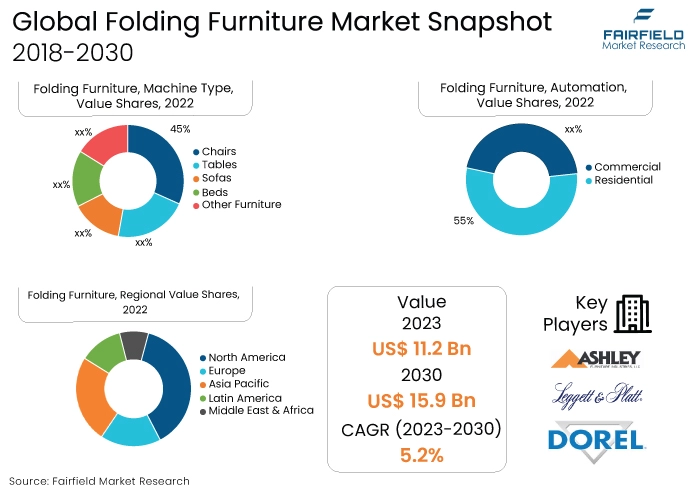
Quick Report Digest
- The key trend driving the folding furniture market is the increasing demand for smart and modular designs. Consumers seek furniture that adapts to various needs and spatial constraints. The integration of intelligent functionalities and modular elements offers versatility, making folding furniture a preferred choice in modern living environments.
- Increasing sustainable practices are expected to drive the folding furniture market as environmentally conscious consumers prioritise eco-friendly options. Manufacturers adopting sustainable materials and production methods contribute to the market's growth, meeting the demand for green alternatives. Sustainability aligns with evolving consumer values and enhances the market appeal of folding furniture.
- Rising disposable income is expected to drive the folding furniture market as consumers with increased purchasing power seek versatile and space-efficient solutions. Higher disposable income enables individuals to invest in innovative and multifunctional furniture, supporting the market's growth by meeting the demand for flexible and adaptable living space solutions.
- Innovative designs are expected to drive the folding furniture market as consumers prioritise aesthetically pleasing and functional solutions. Furniture manufacturers incorporating creative and versatile designs in folding furniture cater to evolving consumer preferences, enhancing the market's appeal. Innovative designs contribute to the product's versatility and adaptability, driving consumer adoption.
- Chairs have captured the largest market share in the folding furniture market due to their universal utility and widespread use in various settings. The versatility and convenience of folding chairs make them popular across residential, commercial, and event spaces, contributing to their dominance in the market.
- Residential applications have captured the largest market share in the folding furniture market due to the increasing demand for space-efficient and adaptable solutions in homes. Consumers seek versatile furniture that complements modern living spaces, and folding furniture, such as chairs and tables, provides practical and functional options, making it popular in residential settings.
- The Asia Pacific region is growing in the folding furniture market due to rapid urbanisation, changing lifestyles, and a rising population. The demand for space-efficient and affordable furniture solutions aligns with the region's dynamic needs. Increasing disposable incomes and a shift towards compact living spaces further contribute to the market's growth in Asia Pacific.
- North America is growing in the folding furniture market due to dynamic urban lifestyles, smaller living spaces, and a preference for versatile and space-efficient solutions. Robust retail infrastructure, high consumer spending, and the trend towards multifunctional furniture contribute to the region's prominence in driving the Folding Furniture market.
A Look Back and a Look Forward - Comparative Analysis
The folding furniture market is experiencing growth due to increasing demand for versatile and space-efficient solutions. As urbanisation and compact living trends rise globally, folding furniture provides a practical and adaptable option for consumers.
The convenience of easily foldable and storable furniture appeals to those with limited space, contributing to the market's expansion. Additionally, ongoing innovations in design and materials enhance the aesthetic appeal and functionality of folding furniture, further driving its popularity.
The growth of the folding furniture market is driven by applications in urban living, outdoor spaces, and versatile interior design. With a rising trend in compact living, folding furniture provides space-saving solutions.
Additionally, the popularity of foldable furniture for outdoor use, such as balconies and patios, contributes to market growth. The versatility of folding furniture in various settings, from small apartments to temporary events, enhances its appeal, fostering demand across different consumer segments.
The future of the folding furniture market appears promising, with a continued focus on compact living solutions, versatility, and sustainable materials. As urbanisation persists, the demand for space-efficient furniture will likely grow.
Innovations in design and materials, coupled with an emphasis on environmental sustainability, will shape the market. Additionally, e-commerce platforms and digital marketing are expected to play a crucial role in reaching consumers and driving the market's evolution.
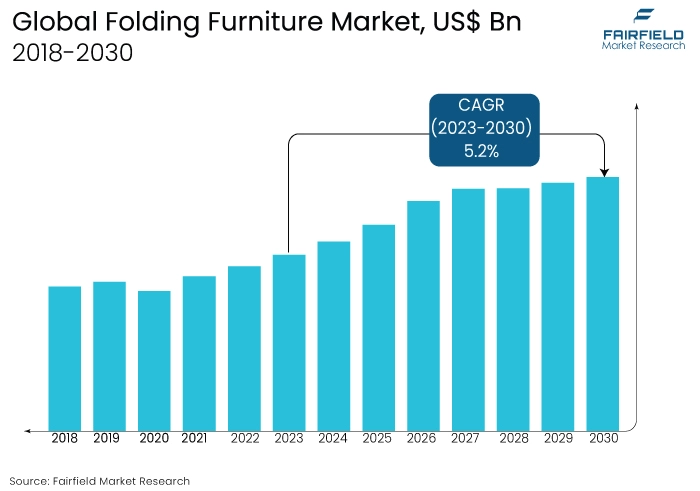
Key Growth Determinants
- Rising Disposable Income, and Improving Standards of Living
The expected growth of the folding furniture market is closely tied to the rise in disposable income levels. As individuals experience an increase in income, there is a greater capacity for discretionary spending on lifestyle and home furnishing products.
Rising disposable income allows consumers to invest in convenient and versatile solutions like folding furniture, meeting the demand for flexible living arrangements.
Consumers are more inclined to explore modern and space-saving furniture options that offer both functionality and aesthetic appeal. This trend is particularly evident in urban areas, where compact living spaces and dynamic lifestyles drive the need for innovative and adaptable furniture solutions, contributing significantly to the growth of the Folding Furniture market.
- Increasing Sustainable Practices
The Folding Furniture market is anticipated to experience growth driven by the increasing emphasis on sustainable practices. Consumers are becoming more environmentally conscious, demanding eco-friendly and responsibly sourced materials in their furniture.
Manufacturers are responding by incorporating sustainable practices, such as the use of recycled materials and environmentally friendly production processes, into the creation of folding furniture. As sustainability becomes a key consideration in purchasing decisions, the market is likely to witness a surge in demand for folding furniture that aligns with these values.
This trend not only caters to eco-conscious consumers but also contributes to the overall positive environmental impact of the Folding Furniture market, fostering long-term growth.
- Innovative Designs
Innovative designs are poised to be a driving force in the growth of the folding furniture market. As consumer preferences evolve, there is a heightened demand for aesthetically pleasing and functionally innovative furniture solutions.
Manufacturers are responding with creative designs that enhance the appeal and versatility of folding furniture, making it a focal point in modern interior and exterior spaces. These designs often incorporate modular elements, customizable features, and unique materials, catering to a diverse range of consumer tastes.
With an emphasis on style and practicality, innovative folding furniture designs are expected to capture the attention of discerning consumers, contributing significantly to market growth as it meets the evolving demands of contemporary living spaces.
Major Growth Barriers
- Limited Design Options
Limited design options pose a challenge to the Folding Furniture market as consumers seek diverse and intricate designs for their living spaces. Foldable furniture, often constrained by structural considerations, may lack the complexity and customisation options available in non-foldable alternatives.
This limitation hinders the market's ability to fully cater to the diverse aesthetic preferences of consumers, potentially impacting purchase decisions. Manufacturers need to innovate and expand design possibilities to address this challenge and enhance the attractiveness of folding furniture in the market.
- Durability Concerns
Durability concerns present a challenge for the Folding Furniture market as consumers may question the longevity and robustness of foldable options compared to traditional furniture. The perception of potential wear and tear or structural instability may discourage some buyers, impacting their confidence in the long-term value of folding furniture.
Manufacturers need to address these concerns through the use of high-quality materials, advanced engineering, and clear communication on the durability of folding furniture to instill confidence and overcome this challenge in the market.
Key Trends and Opportunities to Look at
- Sustainable Materials
The folding furniture market is increasingly adopting sustainable materials to address environmental concerns. Manufacturers are using eco-friendly options such as recycled materials, responsibly sourced wood, and low-impact finishes. This trend not only aligns with consumer preferences for sustainability but also positions folding furniture as an eco-conscious choice in the market.
- Compact Living Solutions
Compact living solutions are a pivotal trend in the folding furniture market, catering to urban lifestyles with limited space. Folding furniture, designed to be space-efficient and versatile, addresses the need for functional yet compact pieces. This trend reflects the growing demand for furniture that complements smaller living spaces in urban environments.
- Smart and Modular Designs
Smart and modular designs are shaping the folding furniture market, integrating innovative features for adaptability. This trend includes furniture with intelligent functionalities and modular elements, allowing users to customise and transform their living spaces.
The demand for smart and modular folding furniture aligns with modern preferences for dynamic and technology-enhanced home solutions.
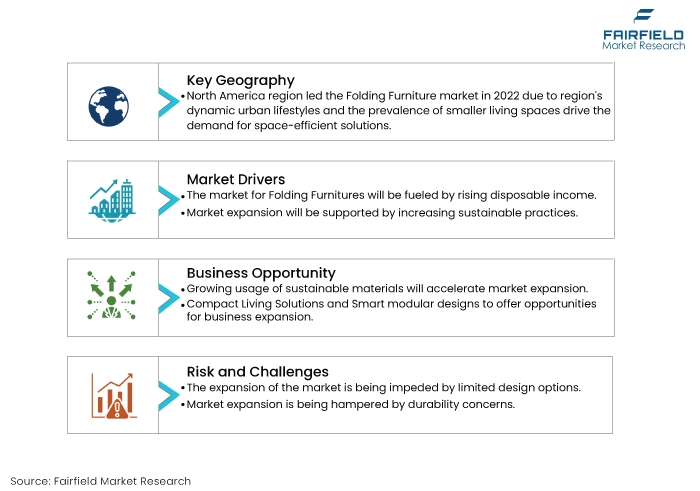
How Does the Regulatory Scenario Shape this Industry?
The regulatory framework for the folding furniture market varies across regions. In the US, the Consumer Product Safety Commission (CPSC) regulates product safety, while in the European Union, conformity with CE marking is crucial. Specific guidelines and standards, such as ASTM F2613-20 for folding chairs, influence product safety.
California's Proposition 65 requires warnings for products containing certain chemicals. In India, the Bureau of Indian Standards (BIS) sets standards for furniture safety. Global certifications like ISO 7170 contribute to international quality benchmarks. Changes in regulations, such as updates to safety standards or environmental requirements, can significantly impact the folding furniture market.
Compliance with these regulations ensures consumer safety and environmental responsibility, influencing market dynamics and consumer trust. Manufacturers need to stay abreast of region-specific regulatory changes to navigate the evolving landscape effectively.
Fairfield’s Ranking Board
Top Segments
- Sales of Chairs Dominant
Chairs have captured the largest market share in the folding furniture market due to their universal utility and versatility. Folding chairs offer practical solutions for various settings, from events and outdoor activities to temporary seating arrangements in homes and offices.
The convenience of foldability, coupled with ergonomic designs, makes folding chairs a preferred choice. Their widespread applicability and ease of storage contribute to their dominant market share, appealing to consumers seeking functional and space-efficient seating solutions.
Tables are poised to see a rapid trail of growth in the market due to the evolving demand for flexible and space-efficient solutions. Folding tables offer versatile applications, catering to diverse settings such as homes, offices, events, and outdoor spaces.
The ability to transform and adapt, coupled with a growing trend for multifunctional furniture, positions folding tables as a dynamic choice. Their rising popularity is driven by the need for adaptable surfaces that can easily accommodate changing spatial requirements in various environments.
- Residential Applications Surge Ahead
Residential applications have secured the largest market share in the folding furniture market due to the increasing emphasis on space optimisation in homes. Folding furniture, such as chairs, tables, and storage units, resonates well with consumers seeking versatile solutions for smaller living spaces.
The adaptability and ease of storage offered by folding furniture align with the needs of residential settings, driving its widespread adoption. The practicality, convenience, and diverse designs cater to homeowners looking for functional yet stylish furnishings in their living spaces.
Commercial applications are likely to witness the highest CAGR through the end of forecast period due to the rising demand for flexible and adaptable solutions in business environments.
The need for versatile furniture options in offices, conference rooms, and event spaces drives the growth of folding furniture. Its ability to optimise space, facilitate easy rearrangement, and cater to dynamic work settings positions it as a preferred choice for commercial applications, contributing to the sector's accelerated growth.
Regional Frontrunners
Preference for Versatility and Convenience Keeps North America at the Forefront
North America has captured the largest market share in the Folding Furniture market due to several factors. The region's dynamic urban lifestyles and the prevalence of smaller living spaces drive the demand for space-efficient solutions. Consumers in North America value versatility, and folding furniture, with its ability to optimise space and provide adaptable solutions, aligns well with these preferences.
Additionally, a robust retail infrastructure, high consumer spending, and a trend towards multifunctional furniture contribute to the market's dominance. The availability of a wide range of folding furniture options catering to diverse needs further solidifies North America's leading position in the folding furniture market.
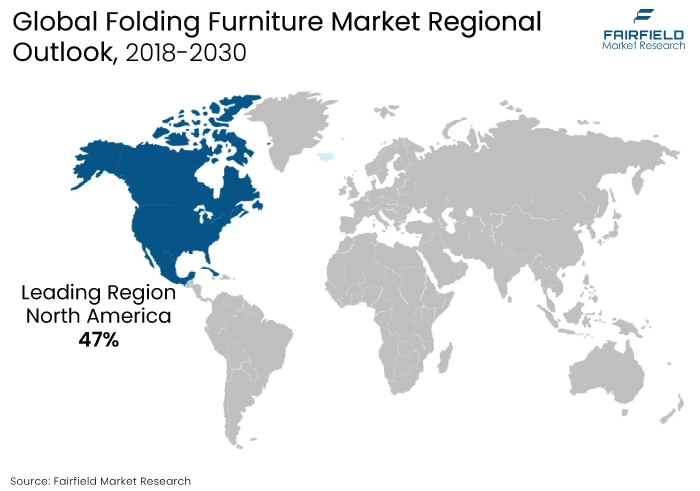
Space-Efficient Furniture Trends Across Asia Pacific
In Asia Pacific, rapid urbanisation, changing lifestyles, and a growing population have increased the demand for space-efficient furniture solutions. Rising disposable incomes, particularly in emerging economies, fuel consumer spending on versatile and affordable furniture.
Additionally, a shift towards compact living spaces in urban areas, and the adoption of multifunctional furniture contribute to the accelerated growth of the folding furniture market in the Asia Pacific region.
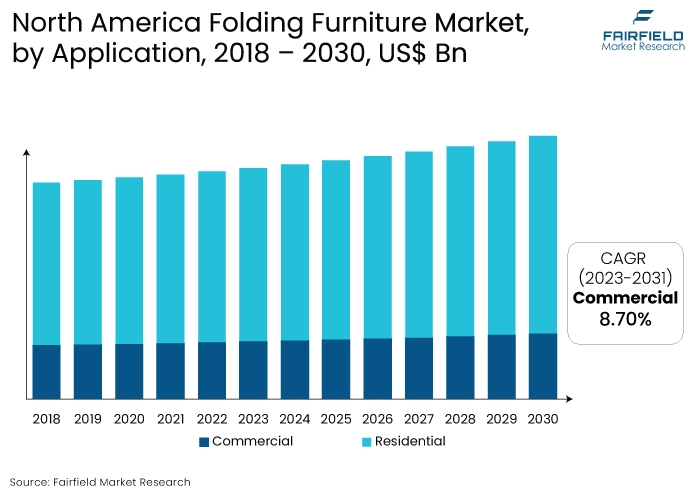
Fairfield’s Competitive Landscape Analysis
The folding furniture market features a competitive landscape with key players such as Ikea, Lifetime Products, and La-Z-Boy. These companies focus on innovative designs, sustainable practices, and diverse product portfolios to gain a competitive edge. Strategic partnerships, mergers, and acquisitions contribute to market dominance.
The competitive landscape is driven by a balance between product quality, pricing strategies, and responsiveness to evolving consumer trends, making it dynamic and competitive as companies vie for market share in the space-efficient furniture segment.
Who are the Leaders in Global Folding Furniture Space?
- IKEA
- Ashley furniture industries inc
- Leggett and Platt Inc
- Dorel Industries Inc
- Haworth Inc
- Expand Furniture
- Murphy wall beds hardware Inc
- Flexsteel industries Inc
- Maxchief Europe
- Hussy seating company
- Aagard Group
- Cosco Home and Office Products
- Roll-A-Bout Corporation
- Acdoco Ltd.
- CORRADI SRL
- Expand Furniture
Significant Industry Developments
New Product Launch
- April 2022: Dorel Home, a division of Dorel Industries Inc., has reopened its 9th-floor C&D Building showroom at the high point market. The showroom serves as a platform to present a range of new products alongside the expanding portfolio of well-known licensed brands in their collection.
- February 2021: Ashley Furniture HomeStore in Guadalajara, Mexico, inaugurated its new 15,000 sq. ft. showroom situated at Avenida Patria #120, in Guadalajara, Jalisco, Mexico. This expansion marks a noteworthy development for the Ashley brand in the Mexican market.
An Expert’s Eye
Demand and Future Growth
The folding furniture market is witnessing increasing demand driven by the growing need for versatile and space-efficient solutions in both residential and commercial spaces.
As urbanisation accelerates and living spaces shrink, consumers seek furniture that can adapt to diverse settings. The future growth of the market is fueled by innovative designs, sustainability trends, and the integration of smart features.
With rising disposable incomes and changing lifestyles, the demand for multifunctional and portable furniture is projected to continue growing, making the folding furniture market a dynamic and evolving segment with significant potential for expansion.
Supply Side of the Market
The demand for folding furniture is propelled by the increasing need for versatile and space-efficient solutions. However, supply dynamics may face challenges due to raw material fluctuations, and supply chain disruptions.
Current pricing structures are influenced by production costs, design innovation, and market competitiveness. Long-term growth will be influenced by pricing strategies that balance affordability and quality. Major trends driving competition include sustainable materials, smart and modular designs, and compact living solutions.
An efficient supply chain is crucial for timely delivery and cost management. Collaborations and innovations along the supply chain will be essential. Overall, the market's future competitiveness hinges on adaptability to evolving consumer preferences, sustainable practices, and a resilient supply chain.
Global Folding Furniture Market is Segmented as Below:
By Product Type:
- Chairs
- Tables
- Sofas
- Beds
- Other Furniture
By Application:
- Residential
- Commercial
By Geographic Coverage:
- North America
- U.S.
- Canada
- Europe
- Germany
- U.K.
- France
- Italy
- Turkey
- Russia
- Rest of Europe
- Asia Pacific
- China
- Japan
- South Korea
- India
- Southeast Asia
- Rest of Asia Pacific
- Latin America
- Brazil
- Mexico
- Argentina
- Rest of Latin America
- Middle East & Africa
- GCC
- South Africa
- Egypt
- Nigeria
- Rest of Middle East & Africa
1. Executive Summary
1.1. Global Folding Furniture Market Snapshot
1.2. Future Projections
1.3. Key Market Trends
1.4. Regional Snapshot, by Value, 2022
1.5. Analyst Recommendations
2. Market Overview
2.1. Market Definitions and Segmentations
2.2. Market Dynamics
2.2.1. Drivers
2.2.2. Restraints
2.2.3. Market Opportunities
2.3. Value Chain Analysis
2.4. Porter’s Five Forces Analysis
2.5. Covid-19 Impact Analysis
2.5.1. Supply
2.5.2. Demand
2.6. Impact of Ukraine-Russia Conflict
2.7. Economic Overview
2.7.1. World Economic Projections
2.8. PESTLE Analysis
3. Global Folding Furniture Market Outlook, 2018 – 2030
3.1. Global Folding Furniture Market Outlook, by Product Type, Value (US$ Mn), 2018 – 2030
3.1.1. Key Highlights
3.1.1.1. Chairs
3.1.1.2. Tables
3.1.1.3. Sofas
3.1.1.4. Beds
3.1.1.5. Other Furniture
3.2. Global Folding Furniture Market Outlook, by Application, Value (US$ Mn), 2018 – 2030
3.2.1. Key Highlights
3.2.1.1. Residential
3.2.1.2. Commercial
3.3. Global Folding Furniture Market Outlook, by Region, Value (US$ Mn), 2018 – 2030
3.3.1. Key Highlights
3.3.1.1. North America
3.3.1.2. Europe
3.3.1.3. Asia Pacific
3.3.1.4. Latin America
3.3.1.5. Middle East & Africa
4. North America Folding Furniture Market Outlook, 2018 – 2030
4.1. North America Folding Furniture Market Outlook, by Product Type, Value (US$ Mn), 2018 – 2030
4.1.1. Key Highlights
4.1.1.1. Chairs
4.1.1.2. Tables
4.1.1.3. Sofas
4.1.1.4. Beds
4.1.1.5. Other Furniture
4.2. North America Folding Furniture Market Outlook, by Application, Value (US$ Mn), 2018 – 2030
4.2.1. Key Highlights
4.2.1.1. Residential
4.2.1.2. Commercial
4.2.2. BPS Analysis/Market Attractiveness Analysis
4.3. North America Folding Furniture Market Outlook, by Country, Value (US$ Mn), 2018 – 2030
4.3.1. Key Highlights
4.3.1.1. U.S. Folding Furniture Market by Product Type, Value (US$ Mn), 2018 – 2030
4.3.1.2. U.S. Folding Furniture Market Application, Value (US$ Mn), 2018 – 2030
4.3.1.3. Canada Folding Furniture Market by Product Type, Value (US$ Mn), 2018 – 2030
4.3.1.4. Canada Folding Furniture Market Application, Value (US$ Mn), 2018 – 2030
4.3.2. BPS Analysis/Market Attractiveness Analysis
5. Europe Folding Furniture Market Outlook, 2018 – 2030
5.1. Europe Folding Furniture Market Outlook, by Product Type, Value (US$ Mn), 2018 – 2030
5.1.1. Key Highlights
5.1.1.1. Chairs
5.1.1.2. Tables
5.1.1.3. Sofas
5.1.1.4. Beds
5.1.1.5. Other Furniture
5.2. Europe Folding Furniture Market Outlook, by Application, Value (US$ Mn), 2018 – 2030
5.2.1. Key Highlights
5.2.1.1. Residential
5.2.1.2. Commercial
5.2.2. BPS Analysis/Market Attractiveness Analysis
5.3. Europe Folding Furniture Market Outlook, by Country, Value (US$ Mn), 2018 – 2030
5.3.1. Key Highlights
5.3.1.1. Germany Folding Furniture Market by Product Type, Value (US$ Mn), 2018 – 2030
5.3.1.2. Germany Folding Furniture Market Application, Value (US$ Mn), 2018 – 2030
5.3.1.3. U.K. Folding Furniture Market by Product Type, Value (US$ Mn), 2018 – 2030
5.3.1.4. U.K. Folding Furniture Market Application, Value (US$ Mn), 2018 – 2030
5.3.1.5. France Folding Furniture Market by Product Type, Value (US$ Mn), 2018 – 2030
5.3.1.6. France Folding Furniture Market Application, Value (US$ Mn), 2018 – 2030
5.3.1.7. Italy Folding Furniture Market by Product Type, Value (US$ Mn), 2018 – 2030
5.3.1.8. Italy Folding Furniture Market Application, Value (US$ Mn), 2018 – 2030
5.3.1.9. Turkey Folding Furniture Market by Product Type, Value (US$ Mn), 2018 – 2030
5.3.1.10. Turkey Folding Furniture Market Application, Value (US$ Mn), 2018 – 2030
5.3.1.11. Russia Folding Furniture Market by Product Type, Value (US$ Mn), 2018 – 2030
5.3.1.12. Russia Folding Furniture Market Application, Value (US$ Mn), 2018 – 2030
5.3.1.13. Rest of Europe Folding Furniture Market by Product Type, Value (US$ Mn), 2018 – 2030
5.3.1.14. Rest of Europe Folding Furniture Market Application, Value (US$ Mn), 2018 – 2030
5.3.2. BPS Analysis/Market Attractiveness Analysis
6. Asia Pacific Folding Furniture Market Outlook, 2018 – 2030
6.1. Asia Pacific Folding Furniture Market Outlook, by Product Type, Value (US$ Mn), 2018 – 2030
6.1.1. Key Highlights
6.1.1.1. Chairs
6.1.1.2. Tables
6.1.1.3. Sofas
6.1.1.4. Beds
6.1.1.5. Other Furniture
6.2. Asia Pacific Folding Furniture Market Outlook, by Application, Value (US$ Mn), 2018 – 2030
6.2.1. Key Highlights
6.2.1.1. Residential
6.2.1.2. Commercial
6.2.2. BPS Analysis/Market Attractiveness Analysis
6.3. Asia Pacific Folding Furniture Market Outlook, by Country, Value (US$ Mn), 2018 – 2030
6.3.1. Key Highlights
6.3.1.1. China Folding Furniture Market by Product Type, Value (US$ Mn), 2018 – 2030
6.3.1.2. China Folding Furniture Market Application, Value (US$ Mn), 2018 – 2030
6.3.1.3. Japan Folding Furniture Market by Product Type, Value (US$ Mn), 2018 – 2030
6.3.1.4. Japan Folding Furniture Market Application, Value (US$ Mn), 2018 – 2030
6.3.1.5. South Korea Folding Furniture Market by Product Type, Value (US$ Mn), 2018 – 2030
6.3.1.6. South Korea Folding Furniture Market Application, Value (US$ Mn), 2018 – 2030
6.3.1.7. India Folding Furniture Market by Product Type, Value (US$ Mn), 2018 – 2030
6.3.1.8. India Folding Furniture Market Application, Value (US$ Mn), 2018 – 2030
6.3.1.9. Southeast Asia Folding Furniture Market by Product Type, Value (US$ Mn), 2018 – 2030
6.3.1.10. Southeast Asia Folding Furniture Market Application, Value (US$ Mn), 2018 – 2030
6.3.1.11. Rest of Asia Pacific Folding Furniture Market by Product Type, Value (US$ Mn), 2018 – 2030
6.3.1.12. Rest of Asia Pacific Folding Furniture Market Application, Value (US$ Mn), 2018 – 2030
6.3.2. BPS Analysis/Market Attractiveness Analysis
7. Latin America Folding Furniture Market Outlook, 2018 – 2030
7.1. Latin America Folding Furniture Market Outlook, by Product Type, Value (US$ Mn), 2018 – 2030
7.1.1. Key Highlights
7.1.1.1. Chairs
7.1.1.2. Tables
7.1.1.3. Sofas
7.1.1.4. Beds
7.1.1.5. Other Furniture
7.2. Latin America Folding Furniture Market Outlook, by Application, Value (US$ Mn), 2018 – 2030
7.2.1. Key Highlights
7.2.1.1. Residential
7.2.1.2. Commercial
7.2.2. BPS Analysis/Market Attractiveness Analysis
7.3. Latin America Folding Furniture Market Outlook, by Country, Value (US$ Mn), 2018 – 2030
7.3.1. Key Highlights
7.3.1.1. Brazil Folding Furniture Market by Product Type, Value (US$ Mn), 2018 – 2030
7.3.1.2. Brazil Folding Furniture Market Application, Value (US$ Mn), 2018 – 2030
7.3.1.3. Mexico Folding Furniture Market by Product Type, Value (US$ Mn), 2018 – 2030
7.3.1.4. Mexico Folding Furniture Market Application, Value (US$ Mn), 2018 – 2030
7.3.1.5. Argentina Folding Furniture Market by Product Type, Value (US$ Mn), 2018 – 2030
7.3.1.6. Argentina Folding Furniture Market Application, Value (US$ Mn), 2018 – 2030
7.3.1.7. Rest of Latin America Folding Furniture Market by Product Type, Value (US$ Mn), 2018 – 2030
7.3.1.8. Rest of Latin America Folding Furniture Market Application, Value (US$ Mn), 2018 – 2030
7.3.2. BPS Analysis/Market Attractiveness Analysis
8. Middle East & Africa Folding Furniture Market Outlook, 2018 – 2030
8.1. Middle East & Africa Folding Furniture Market Outlook, by Product Type, Value (US$ Mn), 2018 – 2030
8.1.1. Key Highlights
8.1.1.1. Chairs
8.1.1.2. Tables
8.1.1.3. Sofas
8.1.1.4. Beds
8.1.1.5. Other Furniture
8.2. Middle East & Africa Folding Furniture Market Outlook, by Application, Value (US$ Mn), 2018 – 2030
8.2.1. Key Highlights
8.2.1.1. Residential
8.2.1.2. Commercial
8.2.2. BPS Analysis/Market Attractiveness Analysis
8.3. Middle East & Africa Folding Furniture Market Outlook, by Country, Value (US$ Mn), 2018 – 2030
8.3.1. Key Highlights
8.3.1.1. GCC Folding Furniture Market by Product Type, Value (US$ Mn), 2018 – 2030
8.3.1.2. GCC Folding Furniture Market Application, Value (US$ Mn), 2018 – 2030
8.3.1.3. South Africa Folding Furniture Market by Product Type, Value (US$ Mn), 2018 – 2030
8.3.1.4. South Africa Folding Furniture Market Application, Value (US$ Mn), 2018 – 2030
8.3.1.5. Egypt Folding Furniture Market by Product Type, Value (US$ Mn), 2018 – 2030
8.3.1.6. Egypt Folding Furniture Market Application, Value (US$ Mn), 2018 – 2030
8.3.1.7. Nigeria Folding Furniture Market by Product Type, Value (US$ Mn), 2018 – 2030
8.3.1.8. Nigeria Folding Furniture Market Application, Value (US$ Mn), 2018 – 2030
8.3.1.9. Rest of Middle East & Africa Folding Furniture Market by Product Type, Value (US$ Mn), 2018 – 2030
8.3.1.10. Rest of Middle East & Africa Folding Furniture Market Application, Value (US$ Mn), 2018 – 2030
8.3.2. BPS Analysis/Market Attractiveness Analysis
9. Competitive Landscape
9.1. Application vs Application Heatmap
9.2. Manufacturer vs Application Heatmap
9.3. Company Market Share Analysis, 2022
9.4. Competitive Dashboard
9.5. Company Profiles
9.5.1. IKEA
9.5.1.1. Company Overview
9.5.1.2. Product Portfolio
9.5.1.3. Financial Overview
9.5.1.4. Business Strategies and Development
9.5.2. Ashley furniture industries inc
9.5.2.1. Company Overview
9.5.2.2. Product Portfolio
9.5.2.3. Financial Overview
9.5.2.4. Business Strategies and Development
9.5.3. Leggett and Platt Inc
9.5.3.1. Company Overview
9.5.3.2. Product Portfolio
9.5.3.3. Financial Overview
9.5.3.4. Business Strategies and Development
9.5.4. Dorel Industries Inc
9.5.4.1. Company Overview
9.5.4.2. Product Portfolio
9.5.4.3. Financial Overview
9.5.4.4. Business Strategies and Development
9.5.5. Haworth Inc
9.5.5.1. Company Overview
9.5.5.2. Product Portfolio
9.5.5.3. Financial Overview
9.5.5.4. Business Strategies and Development
9.5.6. Expand Furniture
9.5.6.1. Company Overview
9.5.6.2. Product Portfolio
9.5.6.3. Financial Overview
9.5.6.4. Business Strategies and Development
9.5.7. Murphy wall beds hardware Inc
9.5.7.1. Company Overview
9.5.7.2. Product Portfolio
9.5.7.3. Financial Overview
9.5.7.4. Business Strategies and Development
9.5.8. Flexsteel industries Inc
9.5.8.1. Company Overview
9.5.8.2. Product Portfolio
9.5.8.3. Business Strategies and Development
9.5.9. Maxchief Europe
9.5.9.1. Company Overview
9.5.9.2. Product Portfolio
9.5.9.3. Financial Overview
9.5.9.4. Business Strategies and Development
9.5.10. Hussy seating company
9.5.10.1. Company Overview
9.5.10.2. Product Portfolio
9.5.10.3. Financial Overview
9.5.10.4. Business Strategies and Development
9.5.11. Aagard Group
9.5.11.1. Company Overview
9.5.11.2. Product Portfolio
9.5.11.3. Financial Overview
9.5.11.4. Business Strategies and Development
9.5.12. Cosco Home and Office Products
9.5.12.1. Company Overview
9.5.12.2. Product Portfolio
9.5.12.3. Financial Overview
9.5.12.4. Business Strategies and Development
9.5.13. Roll-A-Bout Corporation
9.5.13.1. Company Overview
9.5.13.2. Product Portfolio
9.5.13.3. Financial Overview
9.5.13.4. Business Strategies and Development
9.5.14. Acdoco Ltd.
9.5.14.1. Company Overview
9.5.14.2. Product Portfolio
9.5.14.3. Financial Overview
9.5.14.4. Business Strategies and Development
9.5.15. CORRADI SRL
9.5.15.1. Company Overview
9.5.15.2. Product Portfolio
9.5.15.3. Financial Overview
9.5.15.4. Business Strategies and Development
10. Appendix
10.1. Research Methodology
10.2. Report Assumptions
10.3. Acronyms and Abbreviations
|
BASE YEAR |
HISTORICAL DATA |
FORECAST PERIOD |
UNITS |
|||
|
2022 |
|
2018 - 2022 |
2023 - 2030 |
Value: US$ Million |
||
|
REPORT FEATURES |
DETAILS |
|
Product Type Coverage |
|
|
Application Coverage |
|
|
Geographical Coverage |
|
|
Leading Companies |
|
|
Report Highlights |
Key Market Indicators, Macro-micro economic impact analysis, Technological Roadmap, Key Trends, Driver, Restraints, and Future Opportunities & Revenue Pockets, Porter’s 5 Forces Analysis, Historical Trend (2019-2021), Market Estimates and Forecast, Market Dynamics, Industry Trends, Competition Landscape, Category, Region, Country-wise Trends & Analysis, COVID-19 Impact Analysis (Demand and Supply Chain) |
